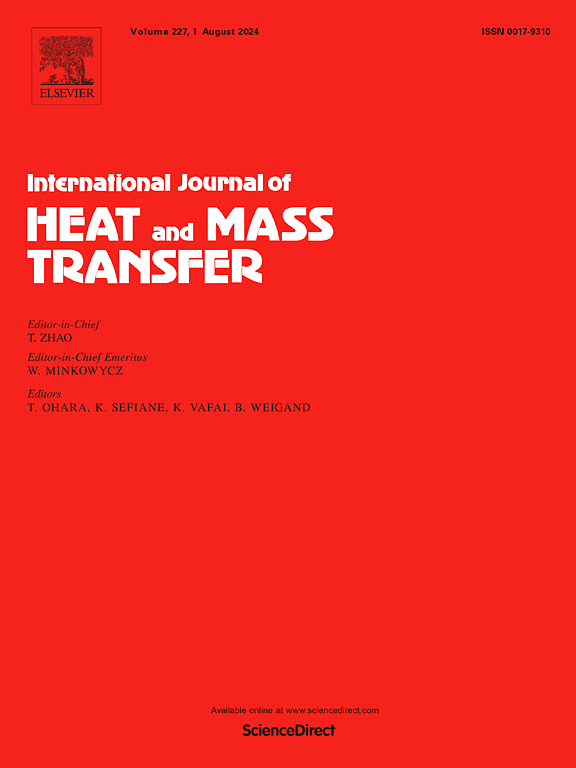Effect of altitude on heat transfer performance of full-scale metal foam heat exchangers produced by additive manufacturing
IF 5
2区 工程技术
Q1 ENGINEERING, MECHANICAL
International Journal of Heat and Mass Transfer
Pub Date : 2024-11-13
DOI:10.1016/j.ijheatmasstransfer.2024.126424
引用次数: 0
Abstract
Increasing altitude negatively impacts heat exchangers efficiency, limiting vehicle power and system performance. To address this, enhancing heat exchangers performance and compactness is crucial. Metal foam, with its high porosity and large specific surface area, is ideal for cooling fins in automotive heat exchangers. This study used laser additive manufacturing with 6061 aluminum powder to fabricate two Kelvin open-cell metal foam heat exchangers: a double-layer (DKHE) and a three-layer (TKHE) structure, both measuring 80 mm × 270 mm × 210 mm. Performance was assessed in a plateau simulation chamber across altitudes from 0 m to 4500 m. Results showed that at a gas flow rate of 1500m³/h at 0 m, the overall heat transfer coefficients for TKHE and DKHE were 1625 W/m2·K and 1301.7 W/m2·K, respectively. At 4500 m, these values dropped by 47.7% and 37.2%, respectively. Pressure drops also decreased by 40% and 39.2%, respectively. The area goodness factor indicated TKHE's superior performance. Additionally, permeability K and inertia coefficient fi, both increasing with altitude, were 36% and 104% higher for TKHE than DKHE. This research applies additive manufacturing for heat exchangers manufacturing which avoids the degradation of heat exchangers performance due to contact thermal resistance. Addressing the performance data gap for metal foam heat exchangers in plateau regions and laying the foundation for future design improvements.
海拔高度对增材制造全尺寸金属泡沫热交换器传热性能的影响
海拔的升高会对热交换器的效率产生负面影响,从而限制车辆的动力和系统性能。为此,提高热交换器的性能和紧凑性至关重要。金属泡沫具有孔隙率高、比表面积大的特点,是汽车热交换器冷却翅片的理想材料。本研究采用 6061 铝粉激光增材制造技术制造了两种开尔文开孔金属泡沫热交换器:双层(DKHE)和三层(TKHE)结构,尺寸均为 80 毫米 × 270 毫米 × 210 毫米。在海拔 0 米至 4500 米的高原模拟室中对其性能进行了评估。结果表明,在 0 米处气体流速为 1500m³/h 时,TKHE 和 DKHE 的总传热系数分别为 1625 W/m2-K 和 1301.7 W/m2-K。在 4500 米处,这些数值分别下降了 47.7% 和 37.2%。压降也分别下降了 40% 和 39.2%。面积优良系数表明 TKHE 性能优越。此外,TKHE 的渗透率 K 和惯性系数 fi 均随海拔高度增加,分别比 DKHE 高 36% 和 104%。这项研究将快速成型技术应用于热交换器制造,避免了接触热阻导致的热交换器性能下降。填补了高原地区金属泡沫热交换器性能数据的空白,为今后改进设计奠定了基础。
本文章由计算机程序翻译,如有差异,请以英文原文为准。
求助全文
约1分钟内获得全文
求助全文
来源期刊
CiteScore
10.30
自引率
13.50%
发文量
1319
审稿时长
41 days
期刊介绍:
International Journal of Heat and Mass Transfer is the vehicle for the exchange of basic ideas in heat and mass transfer between research workers and engineers throughout the world. It focuses on both analytical and experimental research, with an emphasis on contributions which increase the basic understanding of transfer processes and their application to engineering problems.
Topics include:
-New methods of measuring and/or correlating transport-property data
-Energy engineering
-Environmental applications of heat and/or mass transfer

 求助内容:
求助内容: 应助结果提醒方式:
应助结果提醒方式:


